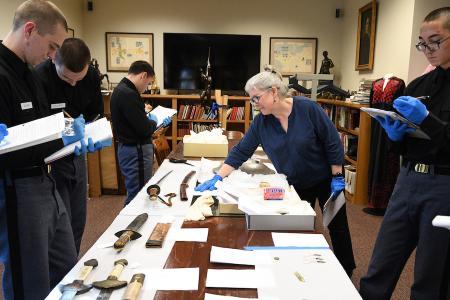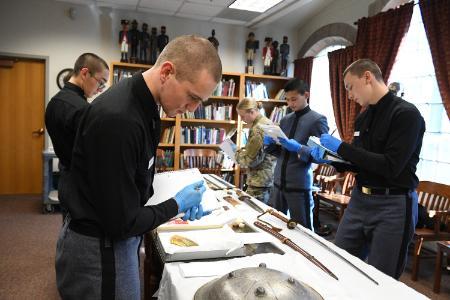VMI Chemistry Majors Study Antiquities
LEXINGTON, Va. Dec. 18, 2023 — Virginia Military Institute cadets enrolled in Lt. Col. Kevin Braun’s general chemistry lab course recently conducted preliminary data analysis on metals in an unconventional place — the VMI Museum.
The VMI Museum was established in 1856 when Maj. Gen. Francis Smith, VMI’s first superintendent, accepted the donation of a Revolutionary War musket. Most of the 15,000 artifacts in the museum have been presented by alumni who used them, or by individuals who acquired antiquities and gifted them to VMI. Many of the objects are not on display but kept in storage, and it was from those pieces that Braun’s class conducted their observations.
The archeology-themed activity called for the cadets to choose two or three of the unidentified displayed artifacts, and use their prior knowledge of metals to speculate their origin, how they were employed, determine what type of materials were used in the making of the object, and how that material fit the purpose of the object.
“Museums are fascinating places chemically and culturally. This activity ties together chemistry, history, and culture, and gave cadets a full liberal arts experience. Archeology lies at the intersection of science and the humanities, so it engages students of all majors,” said Braun.
Museum curator, Catherine DeSilvey, selected artifacts based on their age or metal composition. “I also chose items that have a direct connection to a world event or VMI alumnus. For example, a blade fashioned from a tin can was made by James Berger ’61, while he was held in Vietnam as a prisoner of war for six years. A 14th century Samurai sword was donated by General Thomas Handy, VMI Class of 1914, after World War II, and a gold-plated AK-47 magazine from one of Saddam Hussein’s golden guns was donated by Navy SEAL Chris Beck ’87,” shared DeSilvey. In addition, she showed the cadets Chinese coins dating back to 713 A.D., a bronze spear dating back to 150 to 2000 B.C., Byzantine bronze crosses found in a tomb in Jerusalem, a hand-to-hand combat knife dated 1917, a Roman helmet dated 42 B.C., an Indo-Persian shield about 200 years old, and a hydrodynamic ball used as testing during the Manhattan Project.
Braun was impressed with the vast collection held at the museum. “It’s remarkable what they have in their collection. It is truly a jewel here on post. So many members of the alumni have generously donated their cherished objects, and even though the objects may not be currently on display, they are being used for educational purposes, which should give the donors much pride and satisfaction,” he stated.
 According to Braun, archaeology has relied on chemical methods and instrumentation to characterize, date, and authenticate material remains for over two hundred years. Museums often employ chemists to identify the composition of artifacts, and to determine what was used to preserve them, noting that in the past, dangerous substances like arsenic, strychnine and mercury were used in taxidermy and the preservation of artifacts. “I want the cadets to be aware of the many employment opportunities available with a chemistry degree,” he shared.
According to Braun, archaeology has relied on chemical methods and instrumentation to characterize, date, and authenticate material remains for over two hundred years. Museums often employ chemists to identify the composition of artifacts, and to determine what was used to preserve them, noting that in the past, dangerous substances like arsenic, strychnine and mercury were used in taxidermy and the preservation of artifacts. “I want the cadets to be aware of the many employment opportunities available with a chemistry degree,” he shared.
Jack Neuhart III ’27, a chemistry major from Virginia Beach said, “I was able to use the knowledge of chemistry that I have learned this semester to interact with history. We were able to handle some amazing objects.”
Next semester, Braun plans to continue the investigation of the museum collection by characterizing the metals using a portable X-ray fluorescence spectrometer, acquired through a collaboration with Washington & Lee University. “The resulting data could prove invaluable to the museum staff for the continued preservation of these artifacts, and allow students to better understand the technology required to create them.,” said Braun.
Braun periodically teaches a full semester special topics course on archeological chemistry. He also leads a research group that studies archaeological pottery lipid residue (chemical analysis evidence for milk and meat).
Marianne Hause
Communications & Marketing
VIRGINIA MILITARY INSTITUTE
.svg)
.png)
